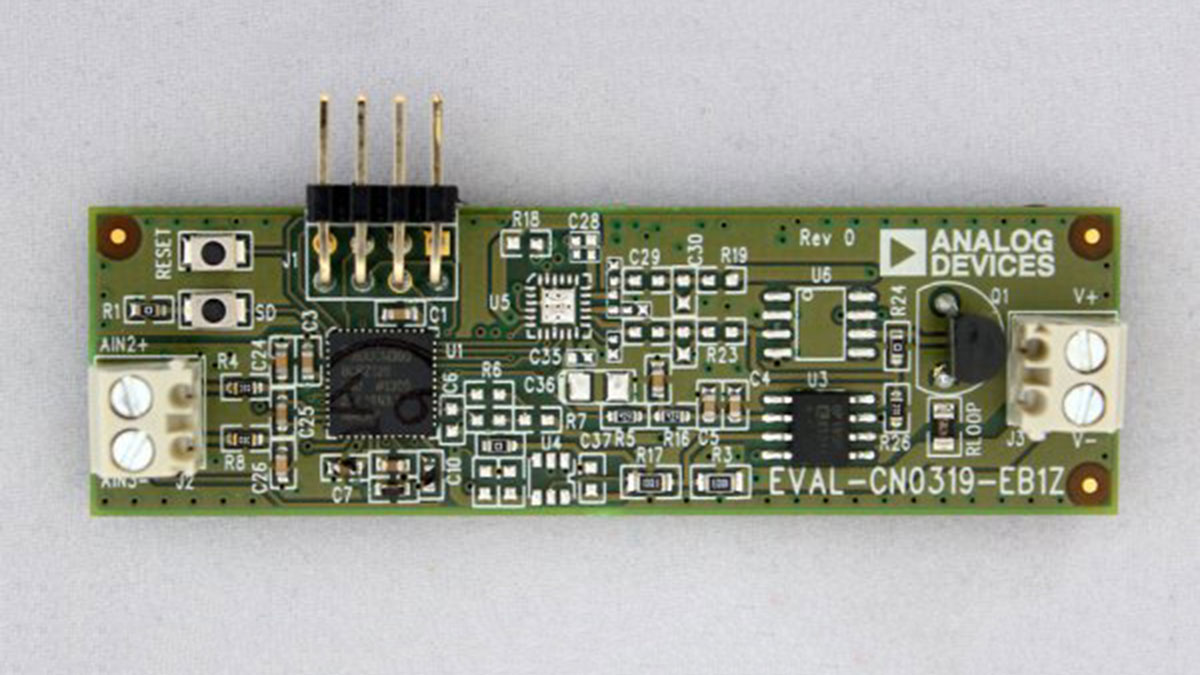The ADuCM360 is a fully integrated, 3.9 kSPS, 24-bit data acquisition system that incorporates dual high performance, multichannel sigma-delta (Σ-Δ) analog-to-digital converters (ADCs), a 32-bit ARM Cortex™-M3 processor, and Flash/EE memory on a single chip. The ADuCM360 is designed for direct interfacing to external precision sensors in both wired and battery-powered applications. The ADuCM361 contains all the features of the ADuCM360 except that only one 24-bit Σ-Δ ADC (ADC1) is available.
The ADuCM360/ADuCM361 contain an on-chip 32 kHz oscillator and an internal 16 MHz high frequency oscillator. The high frequency oscillator is routed through a programmable clock divider from which the operating frequency of the processor core clock is generated. The maximum core clock speed is 16 MHz; this speed is not limited by operating voltage or temperature.
The microcontroller core is a low power ARM Cortex-M3 processor, a 32-bit RISC machine that offers up to 20 MIPS peak performance. The Cortex-M3 processor incorporates a flexible, 11-channel DMA controller that supports all wired communica-tion peripherals (SPI, UART, and I2C). Also integrated on chip are 128 kB of nonvolatile Flash/EE memory and 8 kB of SRAM.
The analog subsystem consists of dual ADCs, each connected to a flexible input mux. Both ADCs can operate in fully differential and single-ended modes. Other on-chip ADC features include dual programmable excitation current sources, diagnostic current sources, and a bias voltage generator of AVDD_REG/2 (900 mV) to set the common-mode voltage of an input channel. A low-side internal ground switch is provided to allow power-down of an external circuit (for example, a bridge circuit) between conversions.
The ADCs contain two parallel filters: a sinc3 or sinc4 filter in parallel with a sinc2 filter. The sinc3 or sinc4 filter is used for precision measurements. The sinc2 filter is used for fast measure-ments and for the detection of step changes in the input signal.

FEATURES and BENEFITS
Analog Input/Output
— Dual 24-bit ADCs (ADuCM360)
— Single 24-bit ADC (ADuCM361)
— Programmable ADC output rate (3.5 Hz to 3.906 kHz)
— See data sheet for additional features
Flexible input mux for input channel selection to both ADCs
Microcontroller
— ARM Cortex™-M3 32-bit processor
— Serial wire download and debug
— Internal watch crystal for wake-up timer
— 16 MHz Oscillator with 8-way Programmable Divider
Memory
— 128k Bytes Flash/EE Memory, 8kB SRAM
— In-circuit debug/download via serial wire and UART
Power Consumption, MCU active mode
— Core consumes 290 μA/MHz
— Overall system current consumption of 1.0 mA with core operating at 500 kHz (both ADCs on, input buffers off, PGA gain of 4, one SPI port on, and all timers on)
Power consumption, power down mode: 4μA (wake-up timer active)
Analog Devices has designed a high-resolution data acquisition chip for 4-20mA current loops around an ARM Cortex-M3 core.
Called ADuCM360, the chip includes dual 4ksample/s 24-bit sigma-delta DACs and flash memory.
“This device draws 1mA of operating current and is designed for direct interfacing to external 4-20mA loop-powered precision sensors in industrial process control,” said ADI. “Low sleep current further enhances use in battery-powered applications.”
The DACs share an 11 input multiplexer, and each has its own programmable gain amplifier.
Both converters can operate in differential or single-ended modes.
“The ADuCM360 is ideal for applications where the second A/D converter is needed for temperature compensation on the sensor or for dual-sensor applications,” said the firm.
For more read: ARM Cortex M3 plus 24bit DACs for 4-20mA loops
